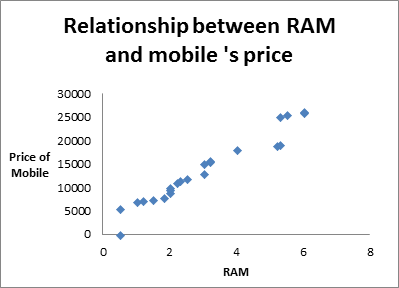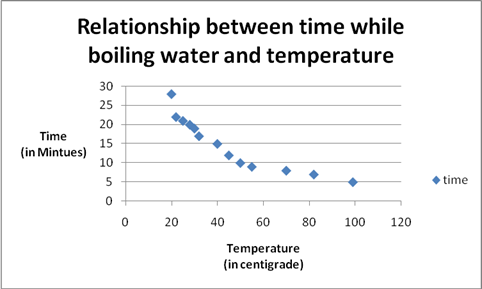
Concept explainers
In addition to the key words, you should also be able to define each of the following terms:
| Positive relationship | ratio scale |
| Negative relationship | self-report measure |
| Accuracy | physiological measure |
| Scale of measurement | behavioral measure |
| Nominal scale | |
| Ordinal scale | artifact |
| Interval scale | subject roles or subject role behaviors |
The definition of the following terms.
Explanation of Solution
Positive Relationship:
In statistics, a positive relationship or positive correlation is defined as the relationship between two variables in which, increment (decrement) in one variable results in increment(decrement) of another variable (not necessarily in same ratio). In other words, positive relationship is the relationship between the two variables in which both variable moves in same direction.
For example, increment in RAM results in increment in price of mobile. The positive relationship can also be seen graphically through scatter plot.

Negative Relationship:
In statistical terms, a negative relationship or negative correlation is defined as the relationship between two variables in which both the variables move in opposite direction, that is, increment(decrement) in the value of one variable results in decrement (increment) of other.
For example, on increasing the temperature of microwave, the time taken by water to boil is decreased.

Accuracy:
Statistics is not about deterministic value, it's about estimated value which is close to accurate value. While doing an experiment, one can never get exact value. So accuracy tells the closeness between true value and estimated value.
For example, a sample is drawn from a population having mean 30 and the sample mean is 29 then one can say that sample mean is accurate to within 1 unit.
Scale of Measurement:
The term 'measurement' is used in our daily lives very broadly but in statistics, the term 'scale of measurement' is used which is more appropriate and is used to categorize the variables. The scale of measurement gives some ways to categorize the variables. The scale of measurement is divided into four scales- nominal, ordinal, interval and ratio scale. Each scale has its own properties on the basis of which the variables can be categorized. This categorization is very useful while performing statistical analysis and without this categorization, it is not possible to perform analysis. The scale of measurement works as base of statistical analysis.
Nominal Scale:
The scale which consists of variables having categories and do not have any order is known as nominal scales and the variables are known as nominal or categorical variables. These variables are simply used as identifiers such as blood group (AB, A, B, O), gender (male and female), residential area (urban and rural) etc.
In this, categories of any variables can be assigned the codes in the form of the numbers and those numbers work as the labels. For a variable gender, male can be assigned as 0 and females as 1.
Ordinal Scale:
The ordinal scale contains the variables having categories and should be placed in order and the variables are known as ordinal variables. For example, ranks achieved in drawing competition, that is, first, second and third positions.
This scale is not used to represent the quantity.
Interval Scale:
The term 'interval' means 'gap in between' which shows the importance about each value between items. An interval scale is a scale in which zero point is arbitrary. In this scale, scores can be added and subtracted but cannot be multiplied meaningfully. For example, temperature because there is no such thing as 'no temperature'.
Ratio Scale:
The scale, consisting of the variable having true zero point is known as the ratio scale. In ratio scale, the percentage is useful unit. For example, weight is expressed in kilograms and also in grams and they are linearly related as 1kg=1000gms. Here 0 kilograms and 0 gram is same and would have no weight.
Self-Report Measure:
In self-report measure, we do a study based on questionnaire or survey. Here, respondents select their responses themselves and questions are based on their feelings, attitudes, behaviour etc. and record their answers.
Self report measures are operational definitions in which respondents are asked to fill the questionnaire about their own behaviour or mental conditions.
Psychological Measurement:
Psychological measurement deals with the measurement of psychological traits or mental abilities like intelligence, aptitude, interest, opinion, honesty or attitude. Psychological characteristics can be measured only with some degree of unreliability. The psychological scale is an interval scale because there is no absolute zero-point on the scale.
Behavioural Measure:
Behavioural measures are tests and methods, targets on information from a subject of interest. It contain over actions and reactions of respondents.
Range Effect:
When each subject of interest receives more than one experimental condition then range effect occurs. The range effects are critical to measurement of almost any kind of human behaviour.
Artefact:
In econometrics, artefact is defined as an error which occurs during data manipulation or in the case of selection of faulty choice of variables.
Subject role or subject role behaviours:
It includes the study of human thoughts and actions, individually as well as collectively. In this, the behaviour and reactions of human are recorded for any particular situation.
Want to see more full solutions like this?
Chapter 3 Solutions
MINDTAP PSYCHOLOGY FOR GRAVETTER/FORZAN
- answerarrow_forwardQuestion 2 The data below provides the battery life of thirty eight (38) motorcycle batteries. 100 83 83 105 110 81 114 99 101 105 78 115 74 96 106 89 94 81 106 91 93 86 79 103 94 108 113 100 117 120 77 93 93 85 76 89 78 88 680 a. Test the hypothesis that mean battery life is greater than 90. Use the 1% level of significance. b. Determine if the mean battery life is different from 80. Use the 10% level of significance. Show all steps for the hypothesis test c. Would your conlcusion in part (b) change at the 5% level of significance? | d. Confirm test results in part (b) using JASP. Note: All JASP input files and output tables should be providedarrow_forwardSuppose that 80% of athletes at a certain college graduate. You randomly select eight athletes. What’s the chance that at most 7 of them graduate?arrow_forward
- Suppose that you flip a fair coin four times. What’s the chance of getting at least one head?arrow_forwardSuppose that the chance that an elementary student eats hot lunch is 30 percent. What’s the chance that, among 20 randomly selected students, between 6 and 8 students eat hot lunch (inclusive)?arrow_forwardBob’s commuting times to work are varied. He makes it to work on time 80 percent of the time. On 12 randomly selected trips to work, what’s the chance that Bob makes it on time at least 10 times?arrow_forward
- Your chance of winning a small prize in a scratch-off ticket is 10 percent. You buy five tickets. What’s the chance you will win at least one prize?arrow_forwardSuppose that 60 percent of families own a pet. You randomly sample four families. What is the chance that two or three of them own a pet?arrow_forwardIf 40 percent of university students purchase their textbooks online, in a random sample of five students, what’s the chance that exactly one of them purchased their textbooks online?arrow_forward
- A stoplight is green 40 percent of the time. If you stop at this light eight random times, what is the chance that it’s green exactly five times?arrow_forwardIf 10 percent of the parts made by a certain company are defective and have to be remade, what is the chance that a random sample of four parts has one that is defective?arrow_forwardQuestion 4 Fourteen individuals were given a complex puzzle to complete. The times in seconds was recorded for their first and second attempts and the results provided below: 1 2 3 first attempt 172 255 second attempt 70 4 5 114 248 218 194 270 267 66 6 7 230 219 341 174 8 10 9 210 261 347 218 200 281 199 308 268 243 236 300 11 12 13 14 140 302 a. Calculate a 95% confidence interval for the mean time taken by each individual to complete the (i) first attempt and (ii) second attempt. [la] b. Test the hypothesis that the difference between the two mean times for both is 100 seconds. Use the 5% level of significance. c. Subsequently, it was learnt that the times for the second attempt were incorrecly recorded and that each of the values is 50 seconds too large. What, if any, difference does this make to the results of the test done in part (b)? Show all steps for the hypothesis testarrow_forward
 Glencoe Algebra 1, Student Edition, 9780079039897...AlgebraISBN:9780079039897Author:CarterPublisher:McGraw Hill
Glencoe Algebra 1, Student Edition, 9780079039897...AlgebraISBN:9780079039897Author:CarterPublisher:McGraw Hill Holt Mcdougal Larson Pre-algebra: Student Edition...AlgebraISBN:9780547587776Author:HOLT MCDOUGALPublisher:HOLT MCDOUGAL
Holt Mcdougal Larson Pre-algebra: Student Edition...AlgebraISBN:9780547587776Author:HOLT MCDOUGALPublisher:HOLT MCDOUGAL Big Ideas Math A Bridge To Success Algebra 1: Stu...AlgebraISBN:9781680331141Author:HOUGHTON MIFFLIN HARCOURTPublisher:Houghton Mifflin Harcourt
Big Ideas Math A Bridge To Success Algebra 1: Stu...AlgebraISBN:9781680331141Author:HOUGHTON MIFFLIN HARCOURTPublisher:Houghton Mifflin Harcourt Linear Algebra: A Modern IntroductionAlgebraISBN:9781285463247Author:David PoolePublisher:Cengage Learning
Linear Algebra: A Modern IntroductionAlgebraISBN:9781285463247Author:David PoolePublisher:Cengage Learning Functions and Change: A Modeling Approach to Coll...AlgebraISBN:9781337111348Author:Bruce Crauder, Benny Evans, Alan NoellPublisher:Cengage Learning
Functions and Change: A Modeling Approach to Coll...AlgebraISBN:9781337111348Author:Bruce Crauder, Benny Evans, Alan NoellPublisher:Cengage Learning




